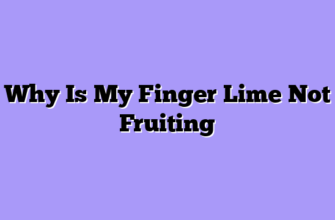I still remember the first time I killed a finger lime tree. Yes, killed. It was a beautiful specimen—a Rainforest Pearl variety that I’d paid good money for—and I managed to destroy it within six months through what I now recognize as textbook overwatering combined with poor drainage. That expensive mistake taught me more about caring for Citrus australasica than any book could have, and I’m going to share those hard-won lessons with you today.
Finger limes, also known as citrus caviar, Australian finger limes, or bush limes in their native habitat, aren’t your typical backyard citrus. They’re rainforest understory plants originally from the subtropical regions along the Queensland and New South Wales border in Australia. Understanding this origin story is absolutely crucial because it explains everything about how to care for them successfully. These aren’t desert-dwelling plants, and they’re not exactly tropical either—they occupy a specific ecological niche that we need to replicate if we want them to thrive.
The good news? Once you understand what these caviar limes actually need, caring for them becomes fairly straightforward. The bad news? If you treat them like regular citrus—say, like an orange or lemon tree—you’re probably going to struggle. Let me walk you through everything I’ve learned about keeping these remarkable Australian natives healthy and productive.
Understanding Your Finger Lime’s Basic Needs
Before we dive into specific care techniques, let’s establish the fundamental requirements that every Citrus australasica specimen needs, regardless of variety or growing location. Think of these as the non-negotiables—mess these up, and nothing else you do will compensate.
Essential Requirements for Healthy Bush Limes:
- Well-draining soil that never becomes waterlogged but retains adequate moisture
- Bright light with at least 6-8 hours of direct sun daily, though afternoon shade helps in hot climates
- Consistent warmth with protection from temperatures below 28-30°F
- Regular feeding during the growing season with appropriate citrus nutrition
- Adequate air circulation to prevent fungal issues and pest buildup
- Slightly acidic to neutral soil pH ranging from 6.0 to 7.0
- Protection from strong winds that can damage branches and desiccate foliage
Each of these factors connects to the others in important ways. For instance, if your soil drainage is poor, even perfect watering practices won’t prevent root problems. If your tree doesn’t receive enough light, it won’t utilize the nutrients you’re providing effectively. Successful cultivation means getting all these pieces working together harmoniously.
I grow my Australian finger limes in several different situations—some in the ground, others in large containers, a few in my greenhouse during winter. Each setup requires slightly different approaches, but the fundamentals remain constant. The trees that thrive are the ones where I’ve nailed these basic requirements from day one.
The Soil Equation
Let’s start with soil because this is where I made my first major mistake and where I see most beginners struggle. Citrus caviar trees need soil that seems almost contradictory in its requirements: it must drain quickly while still holding enough moisture to keep roots hydrated. How do you achieve this magic combination?
The secret lies in soil structure and composition. I’ve tested dozens of mixes over the seasons, and here’s what consistently works best:
| Component | Percentage | Purpose |
|---|---|---|
| Quality potting soil or garden loam | 40-50% | Base material, provides nutrients and structure |
| Pine bark fines or coir | 20-25% | Water retention, organic matter |
| Perlite or pumice | 20-25% | Drainage, prevents compaction |
| Aged compost | 10-15% | Slow-release nutrients, beneficial microbes |
This combination creates a medium that allows water to move through readily while maintaining a reservoir of moisture in the organic components. When I water my trees, I should see water drain freely from the bottom of containers within seconds—not minutes. For in-ground plantings, water should never pool on the surface for more than a few moments.
pH matters more than many growers realize. Finger limes prefer slightly acidic conditions, ideally between 6.0 and 6.8. In areas with alkaline soil like mine, this means regular amendments with sulfur or acidifying fertilizers. I test my soil pH twice yearly—once in early spring and again in midsummer—and adjust as needed. Ignoring pH will lead to nutrient lockout even if you’re fertilizing regularly, resulting in yellowing leaves and poor growth despite your best efforts.
Watering: The Make-or-Break Factor
If I could only give you one piece of advice about caring for bush limes, it would be this: master your watering technique. More trees die from improper watering—usually overwatering—than from any other cause. Yet watering correctly isn’t complicated once you understand what you’re trying to achieve.
Think of the root zone as a sponge. You want that sponge to be moist but not soggy. When you squeeze it, you shouldn’t get streams of water running out, but you should feel definite dampness. This is the sweet spot where roots can access water while still receiving adequate oxygen. Too wet, and roots suffocate and rot. Too dry, and the tree becomes stressed, dropping leaves and fruit.
My Proven Watering Protocol:
- Check soil moisture before watering – Stick your finger or a moisture meter 2-3 inches into the soil near the root zone
- Water only when the top 2-3 inches feel dry – This prevents overwatering while ensuring the tree never experiences true drought
- Apply water slowly and deeply – Take your time, allowing water to penetrate the entire root zone rather than running off the surface
- Water until it drains freely – For container plants, water until it flows from drainage holes; for in-ground trees, water until the top 12 inches of soil are moistened
- Adjust frequency based on conditions – Hot, windy days require more frequent watering; cool, humid conditions need less
- Never let water pool around the trunk – This invites root rot and fungal issues; ensure water disperses evenly throughout the root zone
Seasonal adjustments are critical. During summer’s peak growing season, my containerized Citrus australasica trees need water almost daily. Come winter when growth naturally slows, that drops to once or twice weekly. The tree tells you what it needs if you pay attention—slight leaf drooping signals thirst, while yellowing leaves that drop easily often indicate overwatering.
Container-grown trees require more frequent watering than those in the ground because containers dry out faster. However, they also face greater risk from overwatering because that water has nowhere to go except out the drainage holes. This is why proper container preparation with adequate drainage holes and appropriate soil mix is so crucial.
Water quality deserves mention too. Municipal water with high chlorine or fluoride levels can cause issues over time, particularly tip burn on leaves. I collect rainwater when possible, and when I use tap water, I let it sit overnight to allow chlorine to dissipate. If you have hard water with high dissolved minerals, your trees will eventually show signs of salt buildup—regular flushing with pure water helps prevent this.
Reading Your Tree’s Signals
After caring for these Australian natives season after season, I’ve learned to read the subtle signs that indicate whether my watering practices are on point or need adjustment. Your finger lime will communicate its needs if you know what to look for.

Overwatered trees present differently—yellowing leaves that may drop while still green, a generally unhealthy appearance despite regular care, and potentially a sour smell from the soil indicating anaerobic conditions. Root rot is the ultimate consequence of chronic overwatering, and once it sets in, recovery becomes difficult if not impossible.
Feeding Your Citrus Caviar Trees
Nutrition is where I see the second most common mistakes after watering. Finger limes aren’t heavy feeders compared to some fruiting trees, but they do require consistent nutrition throughout their active growing season. Underfed trees produce sparse foliage, smaller fruit, and show poor overall vigor. Overfed trees can experience nutrient burn, excessive vegetative growth at the expense of fruiting, and increased pest susceptibility.
I take a balanced approach that mimics what these trees would receive in their native rainforest habitat—regular, modest amounts of nutrients rather than heavy feeding. My fertilization schedule has evolved through trial and error, and what I’m sharing here represents what actually works in practice, not just theory.
| Month | Fertilizer Type | Application Rate | Notes |
|---|---|---|---|
| March | Citrus-specific granular (8-4-8 or similar) | Full strength | Spring growth flush begins |
| April-May | Liquid organic fertilizer | Half strength, every 2 weeks | Support active growth |
| June-August | Balanced citrus fertilizer | Full strength monthly | Peak growing season |
| September | Lower nitrogen formula (3-4-6) | Full strength | Harden growth before dormancy |
| October-February | Minimal or none | Quarter strength if any | Respect dormancy period |
Beyond major nutrients (nitrogen, phosphorus, potassium), micronutrients matter tremendously for Citrus australasica. Iron deficiency shows as yellowing leaves with green veins—a condition called chlorosis that’s common in alkaline soils. Zinc and manganese deficiencies cause mottled, distorted new growth. I address these with foliar sprays of chelated micronutrients every 4-6 weeks during the growing season.
Organic fertilizers have given me better results than synthetic options, though I occasionally use both. Fish emulsion, well-aged compost, and worm castings provide slow-release nutrition plus beneficial microbes that support soil health. I side-dress my in-ground trees with compost twice yearly—spring and fall—working it gently into the top few inches of soil around the drip line.
One surprising lesson: less is often more with fertilization. When I first started growing bush limes, I thought more fertilizer would mean more growth and fruit. Wrong. Excessive nitrogen produces lush foliage but reduced flowering and fruit set. The tree puts all its energy into leaves rather than reproduction. Now I err on the side of modest feeding and let the tree’s appearance guide any adjustments.
Light, Temperature, and Environmental Considerations
Getting the environmental factors right makes the difference between a surviving tree and a thriving one. Citrus caviar trees evolved in the dappled light of rainforest understory, which gives us clues about their ideal growing conditions.
Light requirements are substantial—these trees need full sun in most climates to produce well. However, “full sun” means something different in Arizona versus Washington state. In hot, intense sun regions, afternoon shade prevents leaf scorch and reduces water stress. I position my trees where they receive morning sun through early afternoon, then dappled shade during the hottest hours. In cooler climates, maximum sun exposure works fine.
Insufficient light leads to leggy growth, poor fruiting, and increased disease susceptibility. I learned this when I tried growing caviar limes in a partially shaded area of my property—they limped along but never thrived. Moving them to a sunnier spot transformed their performance within a single season.
Temperature management requires attention, especially at the extremes. These Australian finger limes handle brief dips to around 28-30°F once mature, but younger trees are more sensitive. Container-grown specimens are particularly vulnerable because their roots are exposed. When temperatures threaten to drop below 32°F, I move my containerized trees into my greenhouse or garage. For in-ground trees, I use frost blankets draped over a frame—never directly touching the foliage.
Heat tolerance is generally good, but extreme temperatures above 95-100°F combined with low humidity can stress trees. Shade cloth providing 30-50% shade helps during heat waves, and I increase watering frequency to compensate for higher evapotranspiration.
Wind protection often gets overlooked but matters significantly. Strong winds desiccate foliage, break branches, and cause fruit drop. My trees positioned behind windbreaks or structures perform noticeably better than those in exposed locations. If you’re planting in a windy area, establish windbreaks or choose protected spots from the start.
Humidity isn’t usually something you can control outdoors, but it affects how you manage other care aspects. In dry climates, more frequent watering is necessary. In humid regions, air circulation becomes critical to prevent fungal issues. I’ve found that trees grown in naturally humid conditions need more careful attention to spacing and pruning to maintain airflow through the canopy.
Pruning, Training, and Maintenance
Pruning Citrus australasica requires a lighter touch than most citrus. These trees naturally develop a pleasing shape without heavy intervention, and excessive pruning can reduce fruiting potential. My approach focuses on the essentials: removing dead or damaged wood, maintaining good air circulation, and managing size when necessary.
Timing matters. I do any significant pruning in late winter or early spring before new growth begins. This gives the tree maximum time to recover and produce new fruiting wood during the growing season. Light maintenance pruning—removing dead leaves, broken branches, or crossing limbs—happens year-round as needed.
The main goal with bush lime pruning is opening the canopy to allow light penetration and air movement. I selectively thin interior branches that are weak or poorly positioned, focusing on maintaining a scaffold of strong main branches with good spacing. Unlike some citrus that respond well to aggressive heading back, finger limes often react poorly to heavy cutting, so I take a conservative approach.
Pest and disease management on my farm emphasizes prevention over treatment. Healthy, well-cared-for trees naturally resist many problems. That said, certain issues crop up regardless of how well you care for your trees.
Aphids top my pest list—they’re attracted to tender new growth like moths to flame. I inspect new growth weekly during spring and summer, blasting off any aphids with water at the first sign. For heavier infestations, insecticidal soap works effectively without harsh chemicals.
Scale insects are more insidious, establishing slowly and going unnoticed until populations build. I check stems and leaf undersides monthly, scraping off any scale manually or treating with horticultural oil during cooler months when it won’t burn foliage.
Leaf miners create those characteristic squiggly trails through leaves. While unsightly, they rarely cause serious harm to established trees. I tolerate low levels rather than resorting to chemical controls that might harm beneficial insects.
Disease issues have been minimal in my experience, primarily because good cultural practices prevent most problems. Ensuring adequate air circulation, avoiding overhead watering, and never allowing water to pool around the trunk stops most fungal diseases before they start.
Seasonal Care Calendar and Long-Term Success
Caring for citrus caviar trees becomes intuitive once you understand their annual cycle. Here’s how my care routine shifts through the seasons:
Spring (March-May): This is go-time. New growth flushes appear, flowering begins, and trees wake from winter dormancy. I increase watering frequency, begin regular fertilization, inspect carefully for pests, and enjoy watching flowers develop into tiny fruit.
Summer (June-August): Peak growing season means maximum water and nutrient demands. I maintain consistent moisture, continue feeding, provide shade during extreme heat if needed, and watch fruit develop and size up.
Fall (September-November): As temperatures moderate, I reduce feeding and start hardening trees for winter. Fruit on many varieties ripens during this period. I prepare protection for container trees that will need to come inside.
Winter (December-February): Growth naturally slows. I reduce watering frequency significantly, stop or minimize fertilization, protect trees from frost, and plan for the coming season.
Looking after Australian finger limes successfully comes down to consistency and observation. These trees reward attentive care with abundant harvests of those incredible citrus pearls that continue to amaze chefs and food enthusiasts alike. The learning curve exists, certainly, but it’s not insurmountable.
My advice? Start with one tree, learn its needs intimately, and expand from there. Pay attention to how your tree responds to your care—it’s constantly communicating through its growth, foliage color, and overall vigor. Adjust your practices based on what you observe rather than rigidly following any guide, including this one.
The satisfaction of harvesting your own citrus caviar, knowing you’ve nurtured the tree through every stage, makes every bit of effort worthwhile. These remarkable plants have taught me patience, observation skills, and humility—especially that humility part after killing my first tree! But they’ve also brought tremendous joy and a product that never fails to impress anyone who experiences those little flavor-burst pearls for the first time.
Growing Citrus australasica isn’t about perfection; it’s about understanding, adaptation, and consistent care. Get the basics right—proper soil, appropriate watering, adequate nutrition, and good environmental conditions—and your bush limes will thrive for years to come, rewarding you with harvests that make all the learning and effort completely worthwhile.








